Abstract
The seismic damage of underground structures has been extensively investigated, and it has been demonstrated that underground structures located at weak interlayer sites are more prone to damage. In this study, a two-story two-span rectangular frame subway station structure is analyzed. A two-dimensional soil-underground structure model is developed using the large-scale finite element analysis software ABAQUS. The equivalent linear soil-underground structure dynamic time-history analysis method is employed to examine the seismic response of underground structures at weak interlayer sites. Variations in the thickness and shear wave velocity of the weak interlayer soil are analyzed. The seismic mitigation effects of split columns and prototype columns in underground structures at weak interlayer sites are systematically compared. The findings indicate that the relative displacement and internal force of key structural components significantly increase when the weak interlayer intersects the underground structure. Furthermore, as the thickness of the interlayer increases, the displacement and internal force also escalate. When the thickness of the weak interlayer remains constant and the shear wave velocity decreases, the relative displacement and internal force of the key structural components gradually intensify. Replacing ordinary columns with split columns substantially reduces the internal force of the middle column, providing an effective seismic mitigation measure for underground structures.
1. Introduction
The rapid urbanization and expansion of underground rail transit have become essential for alleviating surface transportation pressures and promoting urban development. As China is geographically situated between the circum-Pacific seismic belt and the Eurasian seismic belt, many of its cities with subway systems are in seismically active regions. Seismic damage data of underground structures reveal that these structures, like surface structures, are significantly affected during strong earthquakes, with catastrophic consequences in some cases. For instance, the 1995 Osaka Kobe earthquake in Japan completely destroyed over 30 columns at the Dakai subway station, leading to its collapse [1,2,3,4,5]. Similarly, the 2001 Chi-Chi earthquake in Taiwan and the 2008 Wenchuan earthquake in China caused extensive damage to urban subway systems [6,7].
At present, substantial progress has been made by Chinese scholars in the seismic research of underground structures [8,9,10,11,12,13]. However, most studies have primarily focused on ordinary layered sites. As underground construction scales expand, site conditions become increasingly complex, with weak interlayer sites being a notable example. Weak interlayer sites are characterized by layered or banded weak thin layers formed by soft soil. Due to high moisture content, low strength, and low shear strength, weak interlayer soil is prone to deformation and failure under seismic action, thereby exacerbating damage to underground structures. Consequently, it is imperative to investigate methods for mitigating structural damage at weak interlayer sites. Wu et al. [14] examined the seismic response of underground structures by varying the location and thickness of the weak interlayer. Their results indicated that the presence of weak interlayers significantly impacts seismic response, with the strongest effects occurring when the weak interlayer is located at the center of the structure. Huang et al. [15] analyzed the influence of seismic wave intensity on weak interlayers, demonstrating that the amplification effect is primarily governed by seismic wave velocity. Li et al. [16] investigated the seismic response of subway station structures in weak saturated soil interlayer sites using finite element analysis, finding that the weak interlayer amplifies seismic effects. The amplification is most pronounced when the interlayer is situated in the middle of the station. Dou et al. [17] explored the dynamic response of a two-story three-span subway station structure by considering various seismic waveforms and relative positions of the station and weak interlayer. Their findings underscored the significant influence of the station’s location within the weak interlayer on structural stress and deformation, with the dynamic response peaking when the station is entirely within the weak interlayer.
In order to reduce the seismic damage to underground structures, two main methods are used to achieve seismic mitigation control: one method involves adding isolation materials between the structure and the soil, while the other involves applying an auxiliary seismic isolation device to the key components of the underground structure (such as the middle column). In 1987, the friction pendulum bearing (FPB) was introduced by Zayas et al. [18] at the University of California, Berkeley. The bearing operates based on the principle of a pendulum, with the structural natural period extended through the swaying motion of the upper support and slider. This motion effectively dissipates seismic energy. In practical engineering applications, FPBs have become widely employed. The idea of applying an isolation layer to underground structures was proposed by Zhao et al. [19] and Chen et al. [20], who carried out a series of theoretical analyses and experimental studies. The experiments showed that the seismic mitigation effect becomes more significant as the elastic modulus ratio of the seismic mitigation layer material to the surrounding rock decreases. Du et al. [21] suggested using the rocking column structure instead of the ordinary middle column to reduce damage to the middle column. The research demonstrated that the seismic performance of the new underground frame structure with a rocking column is significantly improved, and it possesses good self-centering ability, achieving the seismic design goals for underground structures.
The middle column of the underground structure is similar to the middle column of the ground structure, as it must bear a large vertical load. Due to the large shear span ratio of the column, shear failure is likely to occur. In response to this phenomenon, Li et al. [22,23] systematically introduced the split column theory, addressing design, structural requirements, split column frames, and the seismic performance of joints. Hao et al. [24] conducted performance experiments on split columns under low cyclic horizontal load and proposed a calculation model for the bearing capacity of split columns. When the split column is subjected to the same vertical load as the ordinary column, it effectively reduces the lateral stiffness of the column and significantly improves the column’s ductility, with enhanced deformation capacity and energy dissipation capacity [25,26]. Li [27] studied the mechanical properties of split columns, examining hysteresis curves, load capacity, and deformation capacity for different separation ratios. The research showed that split columns with varying separation ratios experience compression-bending failure. As the separation ratio decreases, the peak load capacity of the split column increases, ductility decreases, and energy dissipation capacity weakens. This behavior is also applicable to underground structures, effectively alleviating earthquake damage. Xu et al. [28] used the finite element analysis software ABAQUS 2023 to preliminarily examine the influence of split columns on the seismic mitigation effect of underground structures. Xu et al. [28,29,30] proposed applying split columns to underground two-story three-span subway station structures. The results indicated that split columns can effectively prevent the middle column from bearing excessive shear force and bending moment, fully utilizing both the vertical support capacity and horizontal deformation capacity of the split column.
In summary, this paper examines a two-story double-span rectangular frame subway station structure. The finite element analysis software ABAQUS is used to establish an overall model of the soil-underground structure. The equivalent linear soil-underground structure overall dynamic time history analysis method is employed to study the effects of weak interlayer thickness and shear wave velocity of weak interlayer soil. The seismic response of the underground structure under varying weak interlayer conditions is investigated, and the seismic mitigation effects of split middle columns and prototype cast-in-place middle columns in underground structures at weak interlayer sites are systematically compared.
2. Introduction of Split Column Technology
2.1. Force Characteristics of Split Columns
The split column technology utilizes partition plate material to divide a complete reinforced concrete column into several relatively independent unit columns, with its structural diagram shown in Figure 1. Studies [22,23,24,25,26,27] have shown that the use of split columns in ground structures can effectively reduce the flexural bearing capacity of the frame structure, causing its failure mode to shift from shear failure to bending failure. The deformation capacity and ductility of frame columns are significantly improved.
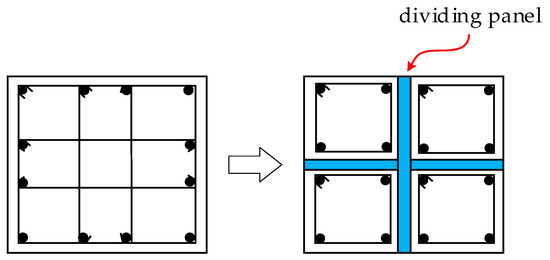
Figure 1.
Structure diagram of split column.
The strain distribution pattern of the split column during loading is given in Figure 2. b denotes the overall width of the column structure and b1 denotes the width of the split unit column.

Figure 2.
Strain distribution of split column concrete.
When the horizontal displacement is small, the friction effect between the clapboard and the unit column provides a strong bonding effect. At this stage, the clapboard effectively constrains the adjacent unit columns to produce a synergistic effect, and the stress variation in the concrete section resembles that of an ordinary column. As the horizontal displacement gradually increases, the friction effect between the partition and the unit column decreases, though it still provides some effective bonding. The deformation ability of the concrete on both sides of the friction restraint partition weakens, and the strain of the inner edge of the cross-section of the unit column on both sides is smaller than that of the outer edge. When the horizontal displacement continues to increase, the friction effect between the partition plate and the unit column disappears completely, and the partition plate no longer restrains the deformation of the unit column. At this point, each unit column operates independently, and the strain neutral axis of the unit column section shifts toward the center of each section.
2.2. Comparative Analysis of Skeleton Curves
Some scholars have designed ordinary reinforced concrete columns and reinforced concrete split columns for pseudo-static experiments based on the actual situation. The failure modes of ordinary reinforced concrete columns and reinforced concrete split columns have been studied. The seismic performance of various components, including ductility, rigidity degeneration, and energy dissipation capacity, is analyzed [25,31]. The reinforcement details of column specimens are shown in Figure 3.
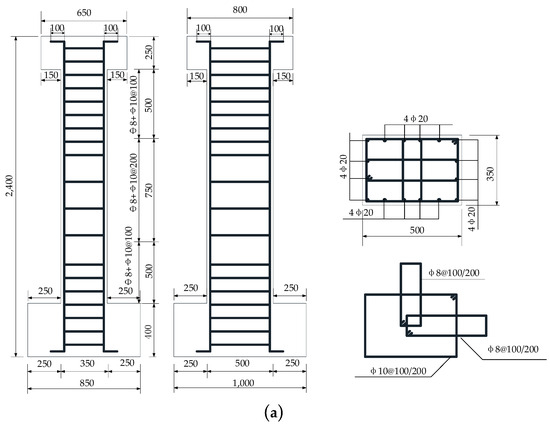
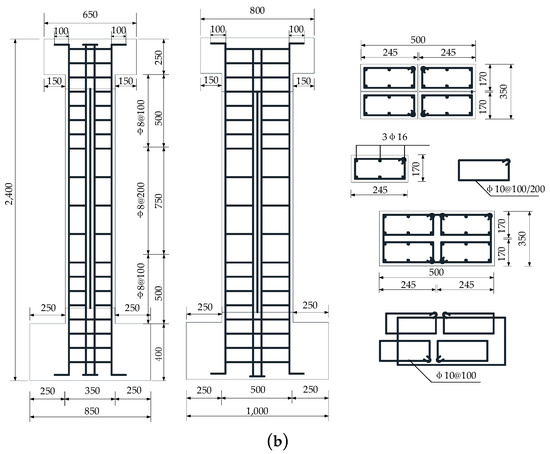
Figure 3.
Reinforcement diagram for each specimen. (a) PTZ. (b) FTZ.
In this paper, finite element analysis software ABAQUS is used to establish models for ordinary concrete columns (PTZ) and reinforced concrete split columns (FTZ), and each module is set up, including components, material properties, assembly, constraints, boundary conditions, analysis steps, and meshing steps. In the model, concrete is modeled using the three-dimensional eight-node reduced integration solid element (C3D8R), the steel bars are modeled using the three-dimensional two-node truss element (T3D2), and the clapboard is also modeled with the three-dimensional eight-node reduced integration solid element (C3D8R). The constitutive model for concrete adopts the plastic damage model, while the ideal double broken line model is used for the steel bars. The concrete constitutive parameters are shown in Figure 4, and additional plastic parameters for concrete are provided in Table 1. To ensure the accuracy of the simulation results, boundary conditions and load settings are kept consistent with the test. The bottom of the column is fixed, and the top of the column is subjected to axial pressure and horizontal displacement constraints. In the interaction module, the steel element is embedded in the concrete element through the built-in area (Embedded) in the module. The simulation model is shown in Figure 5.
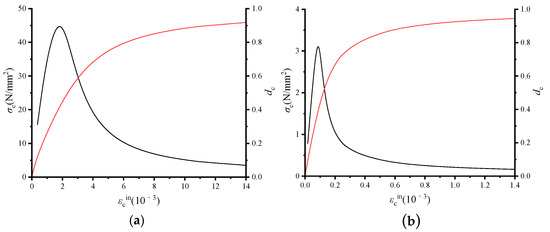
Figure 4.
The relationship between stress, damage factor, and inelastic strain. (a) Compression behavior. (b) Tensile behavior.

Table 1.
Other plasticity parameters of concrete.
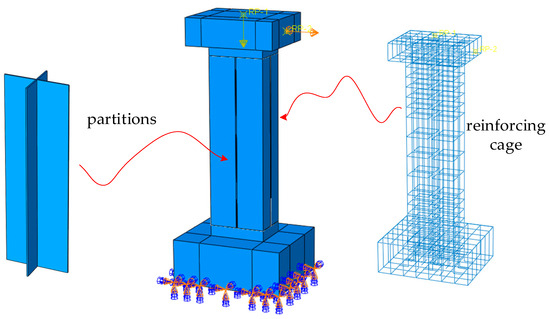
Figure 5.
Finite element model of the specimen.
The skeleton curves of the split column and the whole column under both the test and numerical simulation are extracted, as shown in Figure 6. In the elastic stage, the horizontal load of the structure in the numerical simulation and the test is essentially the same. As the displacement increases, for PTZ, when the displacement reaches 55 mm, both the numerical simulation and the test show that the specimen reaches its peak at the same time. The horizontal peak in the test is approximately 245 kN, while the horizontal peak in the numerical simulation is 240 kN. As the displacement continues to increase, the decrease in horizontal load observed in the test becomes more apparent. When the displacement reaches 120 mm, the horizontal load decreases to 199 kN in the test. The numerical simulation shows that when the displacement reaches 120 mm, the horizontal load decreases to 223 kN. For FTZ, the numerical simulation shows that the horizontal load reaches a peak of 154 kN when the displacement reaches 61 mm. The test shows that the horizontal load reaches a peak of 159 kN when the displacement reaches 91 mm. As the displacement increases further, the decrease in horizontal load observed in the test becomes more noticeable. When the displacement reaches 120 mm, the test shows that the horizontal load drops to 131 kN, while the numerical model shows that the horizontal load drops to 143 kN.
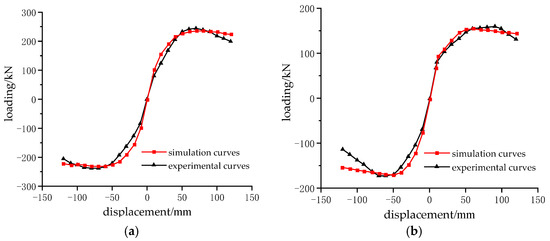
Figure 6.
Comparison of the numerical simulation and experimental skeleton curve. (a) Ordinary column skeleton curve. (b) Split column skeleton curve.
As shown in Figure 7, in the elastic stage, the load–displacement skeleton curves of FTZ and PTZ in the test are essentially consistent, and the load–displacement skeleton curve of PTZ in the numerical simulation is slightly larger than that of FTZ. The experiment shows that when the horizontal load reaches the peak, PTZ increases by approximately 54.1% compared to FTZ, while the numerical simulation shows that when the horizontal load reaches the peak, PTZ increases by approximately 55.8% compared to FTZ.
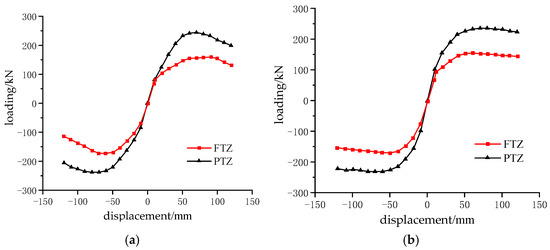
Figure 7.
Comparison of skeleton curves for each specimen. (a) Test skeleton curve. (b) Simulation of skeleton curves.
3. Numerical Model
3.1. Project Profile
The subway station structure model shown in Figure 8 is selected. The model represents a typical double-layer double-span rectangular frame structure. The cross-sectional width of the station is 18 m, and the height of the station is 12 m. The thickness of the left and right walls is 0.8 m, the thickness of the roof is 0.75 m, the thickness of the middle plate is 0.45 m, and the thickness of the bottom plate is 0.8 m. The longitudinal middle column spacing distance is 6 m, and the cross-sectional size of the middle column is 0.8 m × 0.8 m. The station material is C50 strength concrete, with an elastic modulus of 35 GPa, a density of 2500 kg/m3, and a Poisson’s ratio of 0.2. In this model, only the influence of horizontal ground motion is considered. When the middle column of the underground structure is divided, only the direction of the horizontal seismic force is divided, and the longitudinal direction of the station is not divided; that is, the two-column structure. The structural diagram is shown in Figure 9.
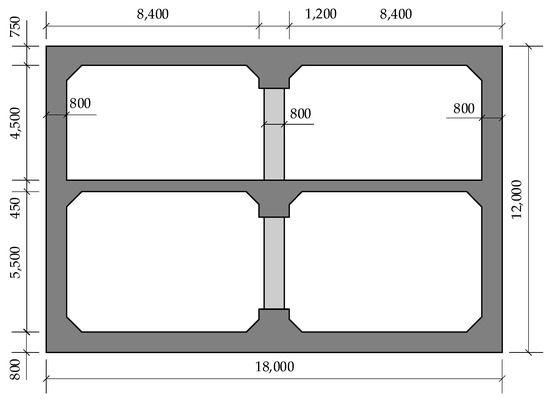
Figure 8.
Cross section of prototype structure.
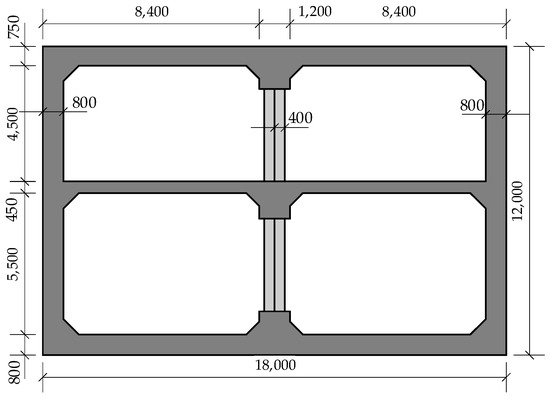
Figure 9.
Cross section diagram of seismic mitigation structure.
Figure 10 shows that the buried depth of the station structure is 6 m. Previous studies have shown that when the weak interlayer is located in the middle of the underground structure, the seismic action has the greatest impact on the underground structure [16]. Therefore, in this model, only the case where the weak interlayer site passes through the middle of the underground structure is considered. The soil conditions of the site are shown in Table 2. The density of the homogeneous soil layer and weak interlayer is 2000 kg/m3, Poisson’s ratio is 0.3, the shear wave velocity of the homogeneous soil layer is 380 m/s, and the shear wave velocities of the four weak interlayers are 150 m/s, 125 m/s, 100 m/s, and 75 m/s, respectively.
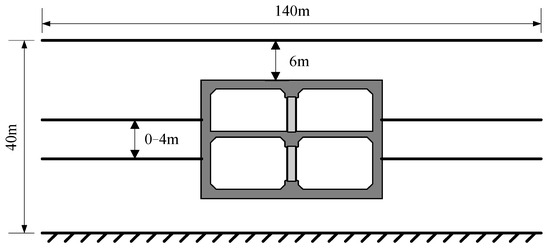
Figure 10.
Schematic diagram of the soil-underground structure.

Table 2.
Physical properties of soils.
To reflect the influence of the thickness of the weak interlayer on the seismic response of the underground structure, four working conditions with the interlayer thickness increasing from 1 m to 4 m are set in this paper. The shear wave velocity of the weak interlayer is 125 m/s, and a working condition without a weak interlayer is set as the reference working condition for comparison. To reflect the influence of the degree of weakness of the weak interlayer on the seismic response of the underground structure, four additional working conditions are set, where the thickness of the weak interlayer is 3 m, and the shear wave velocities of the weak interlayer are 150 m/s, 125 m/s, 100 m/s, and 75 m/s, respectively. The parameters for each working condition are shown in Table 3.

Table 3.
List of operating conditions.
3.2. Finite Element Model
The model was established using the finite element analysis software ABAQUS, as shown in Figure 11 [32]. The calculation and analysis method adopted the overall dynamic time history analysis method of the soil-underground structure, based on equivalent linearization, as proposed by Du et al. [33]. The elastic modulus of the soil layer was calculated using Equations (1) and (2).
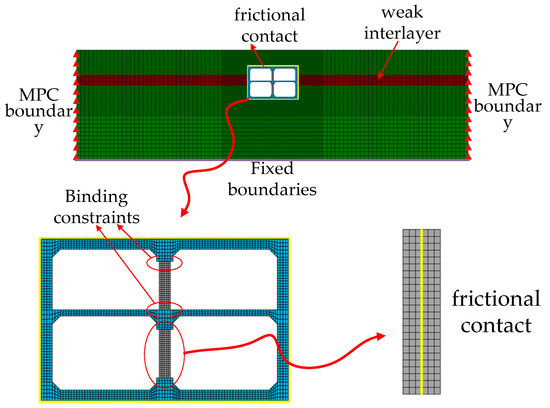
Figure 11.
Two-dimensional finite element model.
Here, ρ represents the density of the soil layer, Vs stands for the shear wave velocity of the soil layer, and ν represents the Poisson’s ratio of the soil layer.
In defining the material properties of the soil layer, the seismic mitigation of the soil material needed to be specified. In this model, the Rayleigh seismic mitigation model was selected. The frequency analysis module in ABAQUS was used to obtain the natural frequency of the test soil. The first-order and second-order frequencies were selected, and the Rayleigh seismic mitigation coefficient was calculated using Formulas (3) and (4).
Here, w1 and w2 are the first and second order self-oscillation frequencies of the soil layer and D is the seismic mitigation ratio taken as 0.1 [34].
The model materials were all elastic constitutive models. The total width of the soil-structure system model was 140 m, and the height was 40 m, which met the requirement of being more than seven times the width of the structure. The middle columns of the station were distributed equidistantly along the longitudinal direction of the station, with a spacing of 6 m between adjacent middle columns. Due to the two-dimensional model adopted in this paper, the station structure used the plane strain unit to establish the model, and the material of the middle column needed to be reduced according to Formula (5) [35].
Here, E′ is the equivalent elastic modulus, ρ′ is the equivalent material density, h is the length of the middle column section along the longitudinal direction of the subway, and h′ is the distance between the two adjacent middle columns in the longitudinal direction.
After reduction, the elastic modulus of the middle column material is 4.67 GPa, the density is 333.3 kg/m3, and the Poisson’s ratio is 0.2. The binding boundary utilizes the MPC (Multi-Point Constraint) node degree of freedom coupling feature within ABAQUS, effectively binding the finite element model nodes of the soil to the boundary nodes at the same height, ensuring these nodes share identical displacements throughout the analysis [36]. Previous studies have shown that the boundary form has good calculation accuracy in soil-structure dynamic analysis [37] and pseudo static analysis [38]. The contact type between the station structure and the surrounding soil is surface-to-surface contact, and the contact property is friction contact. The tangential behavior is considered as the friction force to prevent the relative sliding between surfaces, and the friction coefficient is set to be 0.4. A hard contact is established in the normal direction of the interface. In order to simplify the analysis model, the dividing plate element is not set in the middle column of the seismic mitigation structure. The friction contact is set between the two adjacent unit columns, and the friction coefficient is 0.8 [33]. The soil and structure are simulated by the four-node plane strain element (CPE4R) in ABAQUS. On the grid division, the grid size of the station structure is 0.5 m × 0.5 m, and the soil structure is divided into 0.5 m × 0.5 m grids within 2 times the width of the station. Outside the double width, the vertical grid height is 1 m, the width is 0.5 m, the transverse grid width is 1 m, and the height is 0.5 m.
The Chi-chi wave, Duzce wave, and Manjil wave are selected as input ground motions for dynamic time history analysis. The ground motion input only considers the horizontal seismic action. In the calculation, the peak values of the three seismic waves should be adjusted to make the peak value of the seismic wave be adjusted to 0.1 g. The acceleration time history curve of the ground motion is shown in Figure 12.
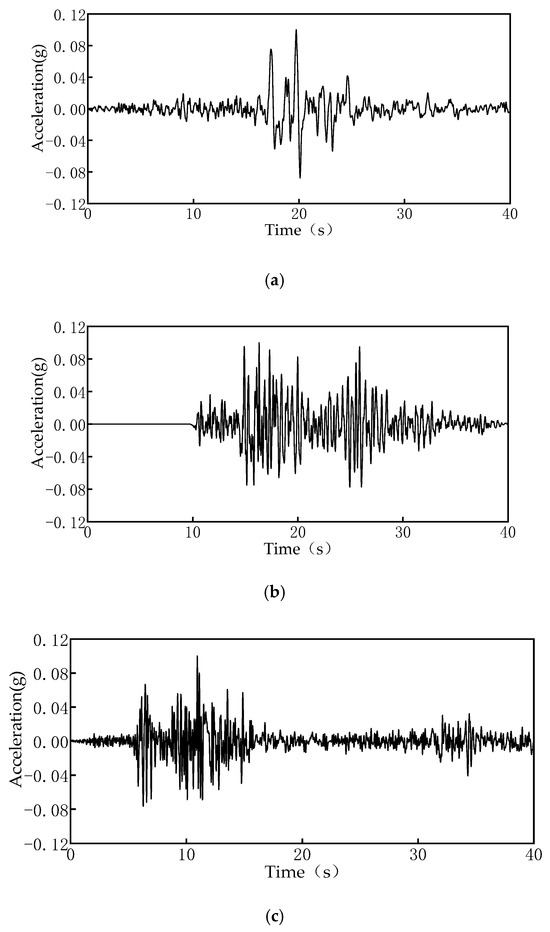
Figure 12.
Input ground motion acceleration time history curve. (a) Chi-Chi earthquake. (b) Dzuce earthquake. (c) Manjil earthquake.
4. Calculation Result
4.1. Prototype Structure
This section mainly analyzes the seismic response behavior of the prototype subway station structure by varying the thickness of the weak interlayer and the shear wave velocity of the weak interlayer.
It has been shown that the bottom of the middle column structure will reach the ultimate bearing capacity first due to its small cross-sectional area, making it a more dangerous cross-section. Furthermore, the seismic response characteristics of the underground structure are relatively affected by displacement [2,39]. Therefore, the absolute value of the relative horizontal displacement between points A and B at the top and bottom of the side wall, as shown in Figure 13, is selected as the horizontal displacement value of the side wall. The absolute value of the relative horizontal displacement between points C and D of the upper middle column is selected as the horizontal displacement value of the upper middle column. The absolute value of the relative horizontal displacement between points E and F of the lower middle column is selected as the horizontal displacement value of the lower middle column. The shear force and bending moment of the S1 cross section at the bottom of the upper middle column are selected as the shear force and bending moment at the bottom of the upper middle column, and the shear force and bending moment of the S2 cross section at the bottom of the lower middle column are selected as the shear force and bending moment at the bottom of the lower middle column. The section bending moment is expressed as the bending moment per meter, with the unit kN·m/m, and the shear force of the section is expressed as the shear force per meter, with the unit kN/m. The horizontal displacement is measured in mm.

Figure 13.
Monitoring points at the structure.
4.1.1. Influence of Weak Interlayer Thickness on the Seismic Response of Underground Structures
It is assumed that the shear wave velocity of the weak interlayer is 125 m/s, and the thickness of the weak interlayer passing through the middle of the underground structure is set to 1 m, 2 m, 3 m, and 4 m, respectively. Four different soil thickness conditions and one condition without a weak interlayer are considered to study the influence of the weak interlayer thickness on the seismic response of the underground structure.
Due to space limitations, only the displacement values of the side wall, the upper middle column, and the lower middle column for the homogeneous site and the weak interlayer with a thickness of 4 m under the Chi-chi earthquake are shown here, as presented in Figure 14. From the figure, it can be observed that when the weak interlayer passes through the middle of the underground structure, the maximum displacement of the side wall of the underground structure is 10.2 mm, which is approximately 171.3% higher than that of the homogeneous site. The maximum displacement of the upper middle column is 4.11 mm, which is increased by approximately 158.5%. The maximum displacement of the lower middle column is 5.1 mm, which is increased by approximately 147.6%. This indicates that the weak interlayer has a negative amplification effect on the deformation of the underground structure.
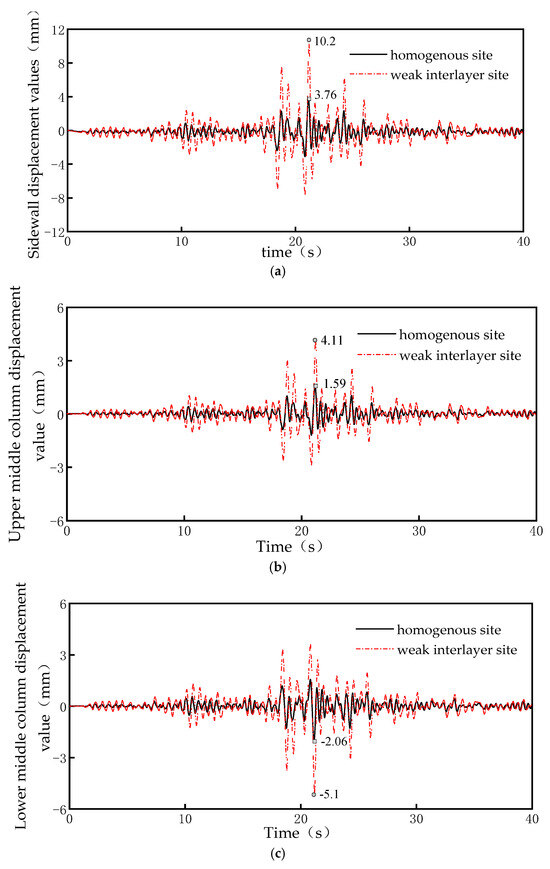
Figure 14.
Displacement values of key structural members under the Chi-chi earthquake. (a) Displacement value of the side wall. (b) Displacement value of the upper middle column. (c) Displacement value of the lower middle column.
The displacement values of the side walls, upper middle columns, and lower middle columns under various working conditions for three different ground motions are further extracted, as shown in Figure 15. From the figure, it can be observed that the displacement values under the weak interlayer site are greater than those under the homogeneous site. With the increase in the thickness of the weak interlayer, the displacement values of the side wall, the upper middle column, and the lower middle column gradually increase.
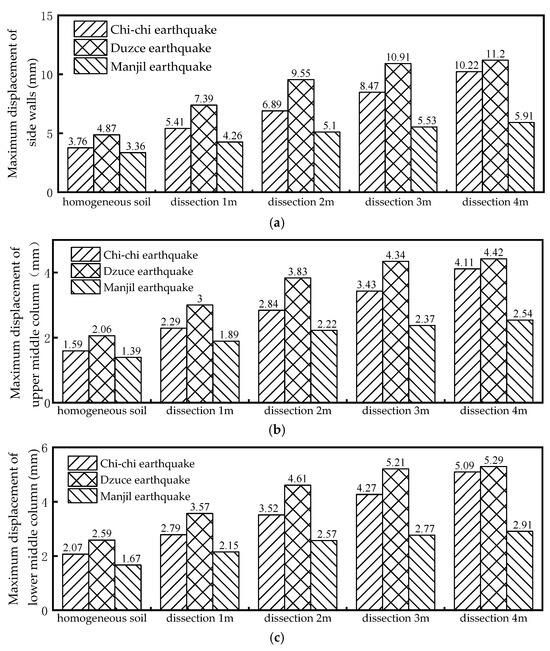
Figure 15.
Maximum displacement of structure in different cases. (a) Maximum displacement of the side wall. (b) Maximum displacement of the upper middle column. (c) Maximum displacement of the lower middle column.
In Figure 16, the maximum shear force and bending moment at the bottom of the middle column and the bottom of the lower middle column are extracted. From the calculation results, it can be seen that in the case of weak interlayer crossing, the internal force at the bottom of the middle column is greater than that of the homogeneous site, and with the increase in the thickness of the weak interlayer, the internal force at the bottom of the middle column also increases.
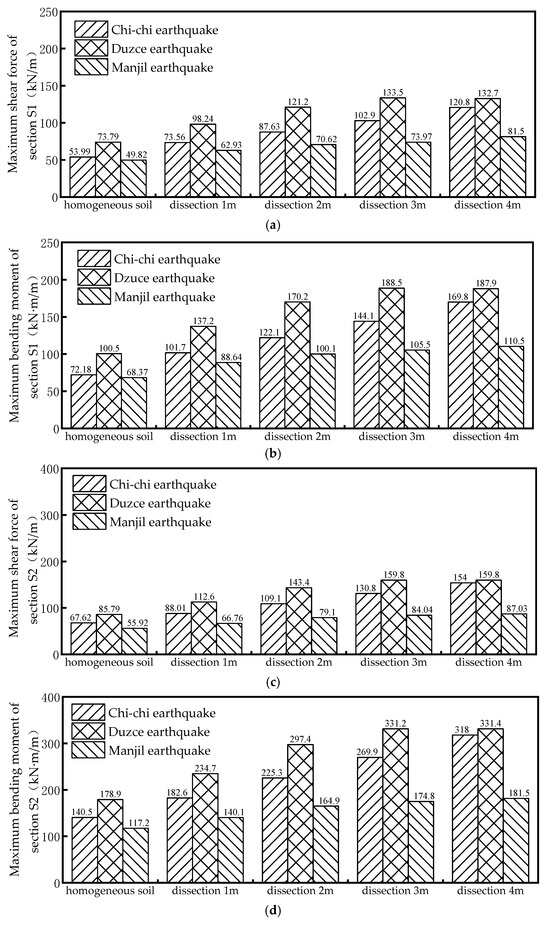
Figure 16.
Internal force value at the bottom of the central column in different cases. (a) Maximum shear at the base of the upper middle column. (b) Maximum bending moment at the bottom of the upper middle column. (c) Maximum shear at the base of the lower middle column. (d) Maximum bending moment at the bottom of the lower middle column.
4.1.2. Influence of the Strength of a Weak Interlayer on the Seismic Response of the Underground Structure
The thickness of the weak interlayer is 3 m, and the shear wave velocity of the weak interlayer is assumed to be 150 m/s, 125 m/s, 100 m/s, and 75 m/s, respectively. Four working conditions with varying shear wave velocities in different soil layers and one condition without a weak interlayer crossing are set up to study the influence of the weak degree of the weak interlayer on the seismic response of the underground structure.
Figure 17 shows the maximum displacement of the side wall, upper middle column, and lower middle column for the homogeneous site and the weak interlayer with a shear wave velocity of 75 m/s under the Chi-chi earthquake. It can be observed from the figure that when a weak layer crosses the underground structure and in the case of soft soil, the maximum displacement of the side wall reaches 16.5 mm. Compared to the homogeneous site, the displacement value increases by 338.8%. The maximum displacement of the upper middle column reaches 6.35 mm, which is 299.4% higher than that of the homogeneous site. The maximum displacement of the lower middle column reaches 8.24 mm, which is 300% higher than that of the homogeneous site. To further analyze the seismic response behavior of the weak interlayer in the underground structure, as shown in Figure 18, the maximum displacement of the key components of the underground structure under various working conditions is extracted. It can be observed from the calculation results that under different ground motions, with the thickness of the weak interlayer remaining constant, the maximum horizontal displacement of the side wall, the upper middle column, and the lower middle column gradually increases as the shear wave velocity decreases (i.e., the weaker the weak interlayer).
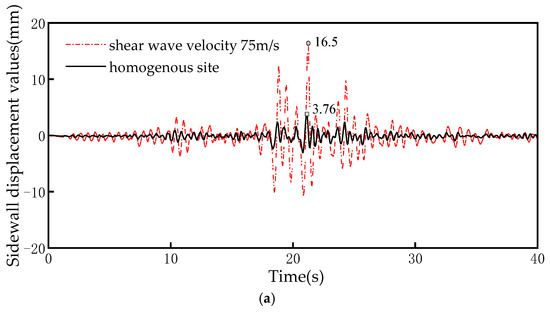
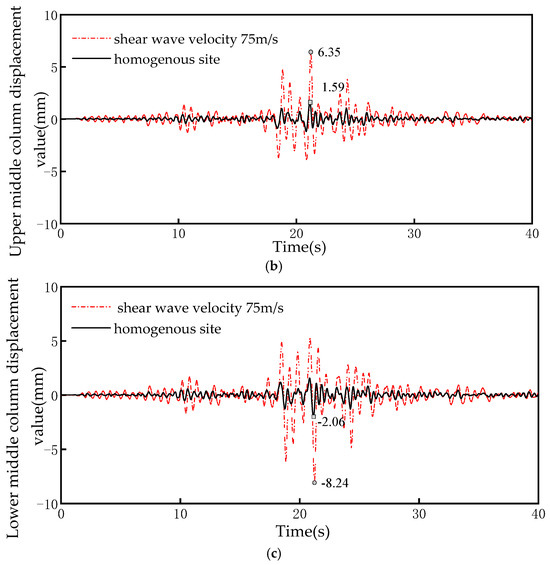
Figure 17.
Displacement values of key structural members under the Chi-chi earthquake. (a) Displacement value of the side wall. (b) Displacement value of the upper middle column. (c) Displacement value of the lower middle column.
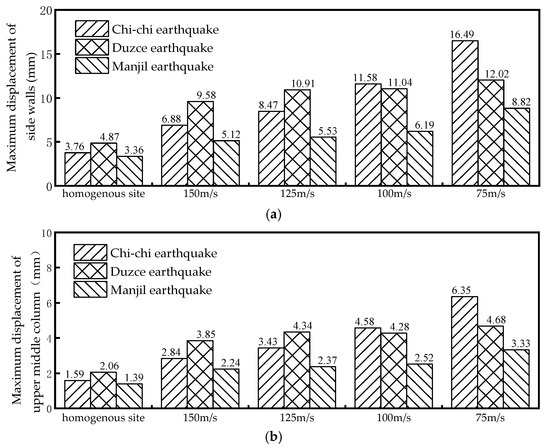
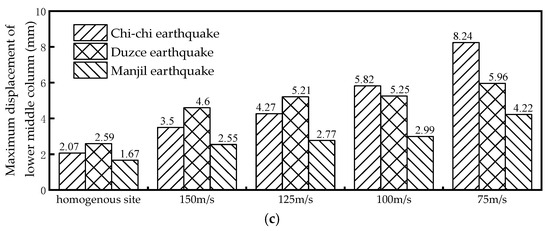
Figure 18.
Maximum displacement of the structure in different cases. (a) Maximum displacement of the side wall. (b) Maximum displacement of the upper middle column. (c) Maximum displacement of the lower middle column.
Figure 19 shows that the maximum shear force and the maximum bending moment at the bottom of the upper and lower columns under each working condition are extracted. From the calculation results, it can be seen that under the action of ground motion, with the decrease in the shear wave velocity of the weak interlayer, the maximum shear force and the maximum bending moment at the bottom of the upper and lower middle columns gradually increase.
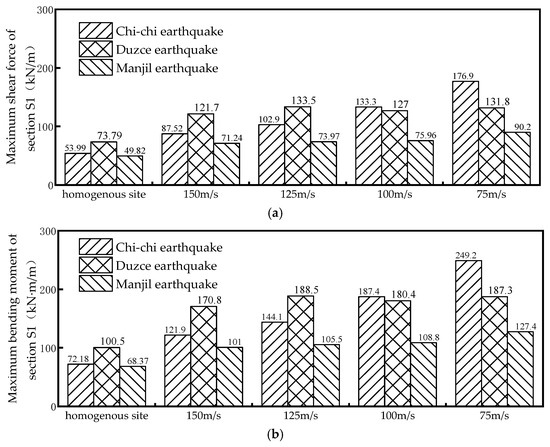
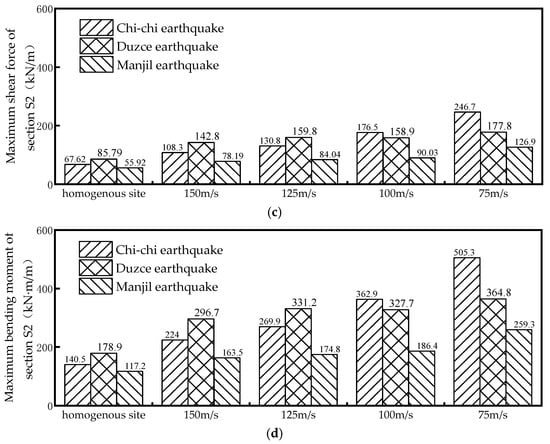
Figure 19.
Internal force value at the bottom of the central column in different cases. (a) Maximum shear at the base of the upper middle column. (b) Maximum bending moment at the bottom of the upper middle column. (c) Maximum shear at the base of the lower middle column. (d) Maximum bending moment at the bottom of the lower middle column.
4.2. Seismic Mitigation Structure
In this section, a comparison and analysis of the split column structure and the ordinary column structure are performed from the perspectives of structural deformation and cross-sectional internal force, and the seismic mitigation effect of the split column is discussed. In terms of deformation, this study selects the relative horizontal displacement at the top and bottom of the side wall, as well as the relative horizontal displacement at the top and bottom of the upper middle column and the lower middle column. In terms of internal force, the shear force and bending moment at the bottom of the upper middle column and the bottom of the lower middle column are selected to compare the differences between the prototype structure and the seismic mitigation structure. The comparison index is expressed by the seismic mitigation rate in this study. The formula is
In the equation, under the same conditions, N0 represents the internal force values within the top and bottom cross-sections of the central columns of the prototype structure, while NR represents the internal force values within the top and bottom cross-sections of the central columns of the seismic mitigation structure.
The comparative values for the prototype structure and the seismic mitigation structure under the homogeneous site are extracted, as shown in Table 4. The table shows that, in terms of structural deformation, the seismic mitigation rate is negative, indicating that the horizontal displacement of the key components of the seismic mitigation structure is greater than that of the prototype structure. The absolute value of the seismic mitigation rate for the lower middle column is the largest, reaching 40%. In terms of internal force, the seismic mitigation effect of the seismic mitigation structure exceeds 60%, and the bending moment at the bottom of the lower middle column reaches 80%. This indicates that the use of the split column instead of the prototype integral column can effectively reduce the internal force of the key components.

Table 4.
Comparative index values of prototype structure and seismic reduction structure under homogeneous site conditions.
4.2.1. Influence of the Thickness of the Weak Interlayer on the Seismic Mitigation Effect of the Underground Structure
The shear wave velocity of the weak interlayer is 125 m/s, and the thickness of the weak interlayer crossing the middle of the underground structure is set to 1 m, 2 m, 3 m, and 4 m, respectively. Four working conditions with different soil thicknesses and one condition without a weak interlayer were established to study the influence of weak interlayer thickness on the seismic mitigation effect of underground structures.
Figure 20 shows the seismic mitigation rate of the displacement of the upper and lower middle columns under different ground motions. It can be observed from the figure that the seismic mitigation rate of the upper and lower middle columns under various working conditions is negative, indicating that the displacement of the seismic mitigation structure under earthquake action is greater than that of the prototype structure.
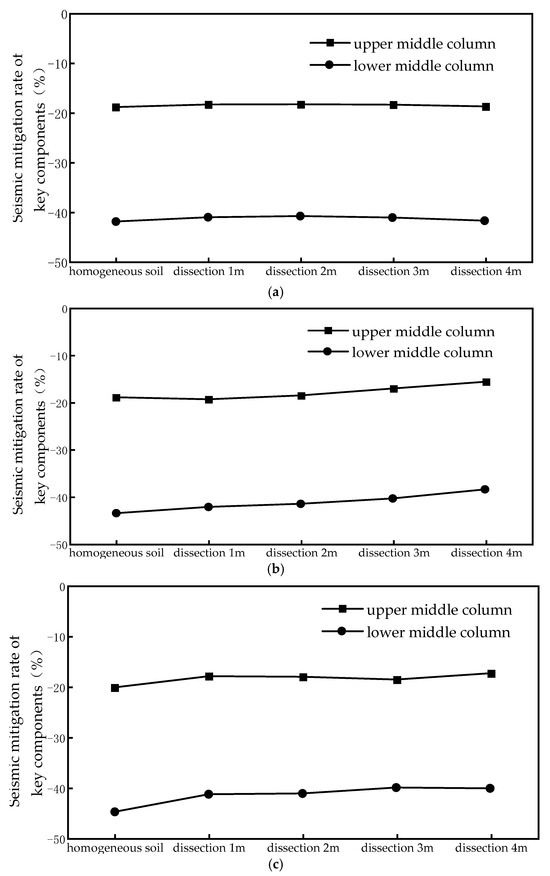
Figure 20.
Displacement seismic mitigation rate of middle columns under different ground shocks. (a) Displacement seismic mitigation ratio under the Chi-chi earthquake. (b) Displacement seismic mitigation ratio under the Duzce earthquake. (c) Displacement seismic mitigation ratio under Manjil earthquake.
The internal force seismic mitigation rate at the bottom of the upper middle column and the bottom of the lower middle column under the Chi-chi earthquake is extracted, as shown in Figure 21. It can be seen from the figure that as the thickness of the weak interlayer increases, the seismic mitigation rate of the internal force in the section of the upper middle column tends to decrease, though the minimum value remains close to 60%. For the lower middle column, the seismic mitigation rate of the internal force in the section tends to increase, with the maximum value approaching 85%. This indicates that the application of split columns in underground stations can significantly reduce the internal force in the key sections. As the thickness of the weak interlayer increases, the influence on the seismic mitigation rate of the upper middle column decreases, while the influence on the seismic mitigation rate of the lower middle column increases.
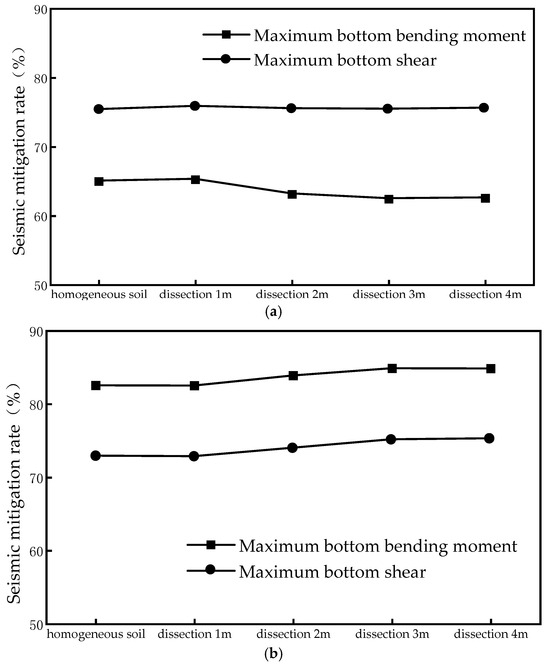
Figure 21.
Comparative index values of key components under the Chi-chi earthquake. (a) Seismic mitigation ratio of the upper middle column under the Chi-chi earthquake. (b) Seismic mitigation ratio of the lower middle column under the Chi-chi earthquake.
4.2.2. Influence of the Weak Degree of the Weak Interlayer on the Seismic Mitigation Effect of the Underground Structure
The thickness of the weak interlayer is set to 3 m, and the shear wave velocity of the weak interlayer is considered to be 150 m/s, 125 m/s, 100 m/s, and 75 m/s, respectively. Four working conditions with varying shear wave velocities in the soil layers and one condition without a weak interlayer were set up to study the influence of the weak interlayer on the seismic reduction effect of underground structures.
Figure 22 shows that the seismic mitigation rate of the displacement of the upper and lower middle columns under different ground motions is negative.
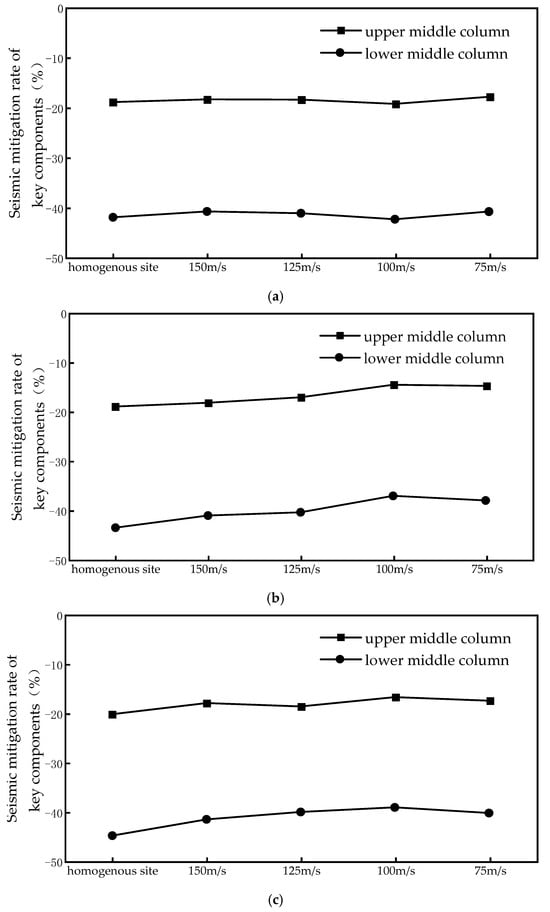
Figure 22.
Displacement seismic mitigation rate of middle columns under different ground shocks. (a) Displacement seismic mitigation ratio under the Chi-chi earthquake. (b) Displacement seismic mitigation ratio under the Duzce earthquake. (c) Displacement seismic mitigation ratio under the Manjil earthquake.
The internal force seismic mitigation rate at the bottom of the upper middle column and the bottom of the lower middle column under the Chi-chi earthquake is extracted, as shown in Figure 23. It can be observed from the figure that, under the action of the earthquake, the internal force seismic mitigation effect of the seismic mitigation structure section is evident. The shear seismic mitigation rate at the bottom section of the upper middle column reaches 80%, and the maximum shear force at the bottom section of the lower middle column reaches 85%. As the shear wave velocity decreases, the seismic mitigation rate of the internal force in the upper middle column tends to decrease, and the bending moment at the bottom decreases significantly. For the lower middle column, the seismic mitigation rate of the internal force in the section tends to increase. The results indicate that as the shear wave velocity decreases (i.e., the weak layer becomes softer), the seismic mitigation effect is weakened for the upper middle column and enhanced for the lower middle column.
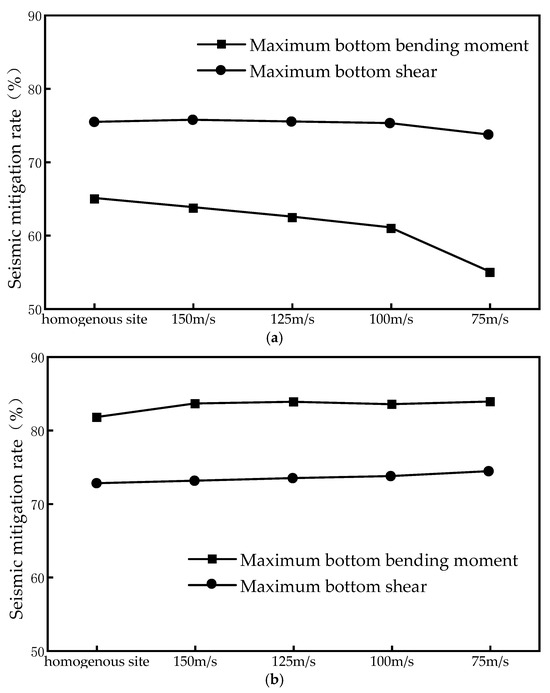
Figure 23.
Comparative index values of key components under the Chi-chi earthquake. (a) Seismic mitigation ratio of the upper middle column under the Chi-chi earthquake. (b) Seismic mitigation ratio of the lower middle column under the Chi-chi earthquake.
4.3. Mechanism Analysis
The soil-structure stiffness ratio [40] defining a rectangular frame structure is shown in Figure 24. In the finite element analysis software ABAQUS, the equivalent soil element and the underground structure are set to be fixed at the bottom, and the unit shear load, τ, is applied at the top and both sides of these elements. The deformations under the respective unit shear loads are then calculated separately. The deformation of the iso-substituted soil unit is recorded as Δsoil, and the deformation of the structure is recorded as Δstr. The soil-structure stiffness ratio, F, is then solved according to Equation (7).
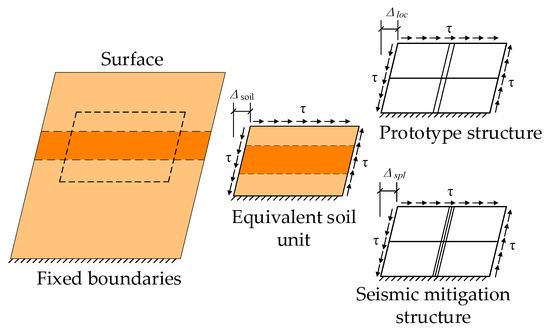
Figure 24.
Calculate model of the soil-structure stiffness ratio.
Figure 25 shows the soil-structure stiffness ratios of the prototype structure and the seismic mitigation structure under five conditions of the extracted weak interlayer, with a shear wave velocity of 125 m/s and a thickness of the weak interlayer passing through the middle of the underground structure. These conditions are presented in the following order: 1 m, 2 m, 3 m, 4 m, and no weak interlayer passing through the homogeneous site. The soil-structure stiffness ratios of the prototype structure and the seismic mitigation structure for five conditions, with shear wave velocities of 150 m/s, 125 m/s, 100 m/s, 75 m/s, and no weak interlayer passing through the homogeneous site, are shown in Figure 26 for the extracted weak interlayer with a thickness of 3 m. The weak interlayer traversing the central part of the subsurface structure is also considered in the order of 150 m/s, 125 m/s, 100 m/s, 75 m/s, and no weak interlayer traversing the homogeneous site. From the calculation results, it can be observed that the soil-structure stiffness ratio of the seismic mitigation structure is greater than that of the prototype structure under all working conditions. This indicates that the horizontal displacement of the seismic mitigation structure is greater than that of the prototype structure due to the use of split columns, which leads to a reduction in the overall stiffness of the structure during seismic mitigation action.
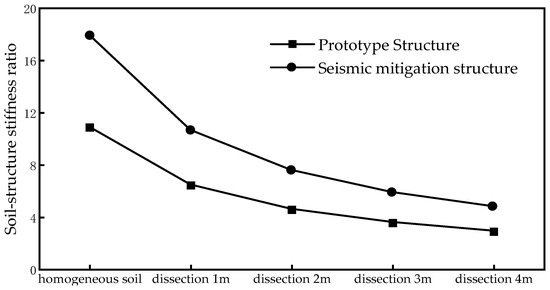
Figure 25.
Soil-structure stiffness ratios for different weak interlayer thicknesses.
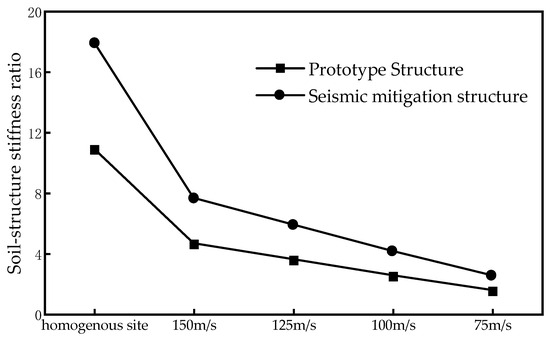
Figure 26.
Soil-structure stiffness ratios for different degrees of softness in soft interlayers.
5. Conclusions
This paper considers the two-story double-span rectangular frame underground station as the research object. A two-dimensional numerical model is established using the finite element analysis software ABAQUS. The soil-underground structure overall dynamic time-history analysis is adopted to study the effect of the soft interlayer thickness and soil condition (i.e., shear wave velocity) on the seismic response of the underground station structure. The seismic mitigation effect of the structure formed by the use of split columns is compared with that of the prototype structure in terms of the lateral displacement rate of key components and the seismic mitigation rate. The following conclusions are drawn:
- (1)
- The quasi-static test results from the numerical simulation and model test show good agreement. The same conclusion can be drawn from the skeleton curves of both the numerical simulation and the model test. When the horizontal load reaches its peak, the traditional column is found to be approximately 55% larger than the split column;
- (2)
- Under earthquake action, when the weak interlayer passes through the underground station, the deformation of the key components of the underground structure increases, and the internal force at the bottom of the middle column also increases. As the thickness of the weak interlayer increases, the relative displacement and internal force of the key components also increase. Additionally, with the increase in weak interlayer thickness, the dynamic response of the interlayer thickness to the underground structure is gradually weakened;
- (3)
- The softer the soil in the weak layer passing through the underground structure (the smaller the shear wave velocity), the greater the relative displacement and internal force of the key components. With the decrease in shear wave velocity, the influence of weakness on the seismic response of underground structures is gradually enhanced;
- (4)
- Compared to the prototype structure, the use of split columns in the underground structure results in a reduction in the overall stiffness of the structure, leading to an increase in the horizontal displacement of the structure;
- (5)
- The application of split columns in underground structures can significantly reduce the internal forces in key sections. The most pronounced seismic mitigation effect is observed in the bending moment at the bottom of the lower middle column, where reductions of up to 85% can be achieved.
In general, at weak interlayer sites, the seismic performance of the station structure can be effectively improved by replacing the ordinary columns with split columns in the subway station structure. The worse the soil quality of the weak layer, the more significant the seismic mitigation effect, making it an effective seismic mitigation measure. This paper only considers the weak interlayer passing through the middle of the subway station. The influence of weak interlayers in other locations and additional factors require further research and analysis.
Author Contributions
Conceptualization, Z.X. (Zigang Xu) and Z.X. (Zongyao Xia); methodology, Z.X. (Zigang Xu); software, Z.X. (Zongyao Xia); validation, Z.X. (Zigang Xu); formal analysis, Z.X. (Zongyao Xia); data curation, Z.X. (Zigang Xu); writing—original draft preparation, Z.X. (Zongyao Xia); writing—review and editing, Z.X. (Zongyao Xia); visualization, Z.X. (Zongyao Xia); project administration, Z.X. (Zigang Xu); funding acquisition, Z.X. (Zigang Xu) and Z.X. (Zongyao Xia). All authors have read and agreed to the published version of the manuscript.
Funding
This research is jointly funded by the National Natural Science Foundation of China (No. 52108453), the Natural Science Foundation of Jiangxi Province (No. 20212BAB214014 and No. 20232BAB204084), the China Postdoctoral Science Foundation Project (No. 2023M741159), and Special Funding Project for Basic Research Operating Costs of the Institute of Engineering Mechanics, China Earthquake Administration (No. 2023D49).
Institutional Review Board Statement
Not applicable.
Informed Consent Statement
Not applicable.
Data Availability Statement
Data are available in a publicly accessible repository.
Conflicts of Interest
The authors declare no conflicts of interest.
References
- Iida, H.; Hiroto, T.; Yoshida, N.; Iwafuji, M. Damage to Daikai subway station. Soils Found. 1996, 36, 283–300. [Google Scholar] [CrossRef]
- Du, X.L.; Li, Y.; Xu, C.S.; Lu, D.; Xu, Z.; Jin, L. Review on damage causes and disaster mechanism of Daikai subway station during 1995 Osaka-Kobe Earthquake. Chin. J. Geotech. Eng. 2018, 40, 223–236. (In Chinese) [Google Scholar]
- Jiang, L.; Chen, J.; Li, J. Seismic response of underground utility tunnels: Shaking table testing and FEM analysis. Earthq. Eng. Eng. Vib. 2010, 9, 555–567. [Google Scholar] [CrossRef]
- Ulgen, D.; Saglam, S.; Ozkan, M.Y. Dynamic response of a flexible rectangular underground structure in sand: Centrifuge modeling. Bull. Earthq. Eng. 2015, 13, 2547–2566. [Google Scholar] [CrossRef]
- Jiang, X.; Wang, F.; Yang, H.; Sun, G.; Niu, J. Dynamic Response of Shallow-Buried Small Spacing Tunnel with Asymmetrical Pressure: Shaking Table Testing and Numerical Simulation. Geotech. Geol. Eng. 2018, 36, 2037–2055. [Google Scholar] [CrossRef]
- Wang, W.L.; Wang, T.T.; Su, J.J.; Lin, C.H.; Seng, C.R.; Huang, T.H. Assessment of damage in mountain tunnels due to the Taiwan Chi-Chi earthquake. Tunn. Undergr. Space Technol. 2001, 16, 133–150. [Google Scholar] [CrossRef]
- Wang, Z.; Gao, B.; Jiang, Y.; Yuan, S. Investigation and assessment on mountain tunnels and geotechnical damage after the Wenchuan earthquake. Sci. China Ser. E Technol. Sci. 2009, 52, 546–558. [Google Scholar] [CrossRef]
- Zhuang, H.; Tang, B.Z.; Yu, B.Y.; Xu, Z.G.; Zhang, J.; Zhou, Z.W. Review and Prospect of Earthquake Resistance and Seismic Isolationof Underground Structures. Technol. Earthq. Disaster Prev. 2023, 18, 1–12. [Google Scholar]
- Chen, G.X.; Su, C.; Du, X.L.; Lu, D.C. Review of Seismic Damage, Model Test, Available Design and Analysis Methods of Urban Underground Structure: Retrospect and Prospect. J. Disaster Prev. Mitig. Eng. 2016, 36, 1–23. [Google Scholar]
- Yang, W.; Xu, M.; Peng, W.; Liu, T. Optimization Study on Key Technology of Improved Arch Cover Method Construction for Underground Metro Stations Based on Similar Model Test. Appl. Sci. 2024, 14, 3982. [Google Scholar] [CrossRef]
- Maleska, T.; Beben, D.; Vaslestad, J.; Sergei Sukuvara, D. Application of EPS Geofoam below Soil–Steel Composite Bridge Subjected to Seismic Excitations. J. Geotech. Geoenviron. Eng. 2024, 150, 04024115. [Google Scholar] [CrossRef]
- Chen, Z.H.; Ni, P.P.; Cheng, C.; Jia, P.; Hu, D.; Wu, M. Monitoring interaction of shallowly buried, large-section, and long-distance twin box jacking tunnels with small spacing under the Beijing-Hangzhou Grand Canal. Tunn. Undergr. Space Technol. 2024, 153, 105973. [Google Scholar] [CrossRef]
- Mubarak, A.G.; Knappett, J.; Brown, M. Numerical simulation of large tunnel alignments under seismic loading: The Large Hadron Collider as a case study. Tunn. Undergr. Space Technol. 2025, 157, 106315. [Google Scholar] [CrossRef]
- Wu, Y.; Xu, Z.G.; Du, X.L. Analysis of effects of weak interlayer on seismic responses of underground structures. J. Zhengzhou Univ. (Eng. Sci.) 2021, 42, 91–97. [Google Scholar]
- Huang, R.Q.; Yu, J.S. Modelling of the Effects of Properties of a Buried Weak Layer on Seismic Waves. J. Eng. Geol. 2003, 11, 312–317. [Google Scholar]
- Li, W.H.; Zhao, C.G.; Du, N.X. Analysis of effects of sat-urated soft interlayer on seismic responses of metro station. Rock Soil Mech. 2010, 31, 3958–3963. (In Chinese) [Google Scholar]
- Dou, Y.M.; Feng, F.; Wang, J.N.; Fan, J.C.; Zheng, S.Y. The 3D Seismic Response Analysis of Subway Station Built in Weak Interlayer. Struct. Eng. 2019, 35, 140–148. [Google Scholar]
- Zayas, V.A.; Low, S.S.; Mahin, S.A. A simple pendulum technique for achieving seismic isolation. Earthq. Spectra 1990, 6, 317–333. [Google Scholar] [CrossRef]
- Zhao, W.S.; Chen, W.Z.; Yang, D.S. Interaction between strengthening and isolation layers for tunnels in rock subjected to SH waves. Tunn. Undergr. Space Technol. 2018, 79, 121–133. [Google Scholar] [CrossRef]
- Chen, Z.Y.; Liang, S.B.; Shen, H.; He, C. Dynamic centrifuge tests on effects of isolation layer and cross-section dimensions on shield tunnels. Soil Dyn. Earthq. Eng. 2018, 109, 173–187. [Google Scholar] [CrossRef]
- Du, X.L.; Wang, Z.L.; Liu, H.T. Study of a seismic new system of underground frame structure based on toughness design. Technol. Earthq. Disaster Prev. 2018, 13, 493–501. (In Chinese) [Google Scholar]
- Li, Z.X. Theory and technology of split reinforced concrete columns. Eng. Mech. 2005, 22, 128–140. (In Chinese) [Google Scholar] [CrossRef]
- Li, X.Z.; Hao, Y.X.; Zhang, J.Y.; Kang, G.Y.; Hu, Q.C.; Xu, Y.F. Research on seismic behavior of interior beam-column joints of reinforced concrete frames with split columns. J. Build. Struct. 2001, 22, 55–60. (In Chinese) [Google Scholar]
- Hao, Y.C.; Hu, Q.C.; Xu, Y.F.; Kang, G.Y. Experimental study on bearing capacity of separated columns under horizontal cyclic loading. J. Build. Struct. 1999, 20, 18–25. (In Chinese) [Google Scholar]
- Li, Z.X.; Hao, Y.C.; Zhou, B.; Kang, G.; Hu, Q.; Xu, Y. Model experimental study on seismic behavior of reinforced concrete frame with split columns. J. Build. Struct. 2003, 24, 1–10. (In Chinese) [Google Scholar]
- Ma, Q.Y.; Zhao, G.Q.; Jiang, C.Y. Experimental research on seismic performance of central column in metro station. Build. Struct. 2021, 51, 77–85. (In Chinese) [Google Scholar]
- Li, R.W. Experimental Study on the Mechanical Behavior of Split Columns with Different Separation Ratios. Master’s Thesis, Yantai University, Yantai, China, 2017. (In Chinese). [Google Scholar]
- Xu, C.S.; Wang Yang, X.S.; Du, X.L.; Xu, Z.G.; Zhang, Z.H. Seismic mitigation effects of split columns in underground station structures. Chin. J. Geotech. Eng. 2021, 43, 624–633. (In Chinese) [Google Scholar]
- Xu, Z.G.; Xia, Z.Y.; Zhuang, H.Y.; Zhang, Q.; Zhang, J.; Tang, B.Z. Research on seismic performance of subway station structure based on split column. Technol. Earthq. Disaster Prev. 2023, 18, 27–36. [Google Scholar]
- Xu, Z.; Xia, Z.; Bu, X.; Han, R. Research on Seismic Performance of a Two-Story, Two-Span Underground Subway Station with Split Columns Based on the Quasi-Static Method. Appl. Sci. 2024, 14, 4077. [Google Scholar] [CrossRef]
- Zhao, G.Q. Research on Seismic Performance of Split Central Column of Metro Station. Master’s Thesis, Chang’an University, Xi’an, China, 2021. [Google Scholar]
- Systèmes, D. Abaqus analysis user’s manual. Simulia Corp. Provid. RI USA 2007, 671, 672. [Google Scholar]
- Du, X.L.; Xu, Z.G.; Xu, C.S.; Li, Y.; Jiang, J.W. Time-history analysis method for soil-underground structure system based on equivalent linear method. Chin. J. Geotech. Eng. 2018, 40, 2155–2163. [Google Scholar]
- Xu, Z.G.; Du, X.L.; Xu, C.S.; Zhang, C.Y.; Jiang, J.W. Comparison of determination methods of site Rayleigh seismic mitigation coefficients in seismic responses analysis of underground structures. Rock Soil Mech. 2019, 40, 4838–4847. (In Chinese) [Google Scholar]
- Xue, R.L. Seismic Elasto-plastic Analysis of Subway Station Structure. Master’s Thesis, Southeast University, Nanjing, China, 2018. (In Chinese). [Google Scholar]
- Kampitsis, A.E.; Sapountzakis, E.J.; Giannakos, S.K.; Gerolymos, N.A. Seismic soil-pile-structure kinematic and inertial interaction-A new beam approach. Soil Dyn. Earthq. Eng. 2021, 55, 211–224. [Google Scholar] [CrossRef]
- Zhong, Z.L.; Shi, Y.B.; Li, J.Q.; Zhao, M.; Du, X.L. Seismic performance assessment of subway station structures considering fuzzy probability of damage states. Chin. J. Geotech. Eng. 2022, 44, 2196–2205. (In Chinese) [Google Scholar]
- Han, R.B.; Xu, C.S.; Xu, Z.G.; Jiang, J.W.; Du, X.L. A boundary forced response displacement method for seismic analysis of symmetrical underground structures. Eng. Mech. 2021, 38, 50–60. (In Chinese) [Google Scholar]
- Du, X.L.; Xu, Z.G.; Xu, C.S.; Li, Y. Inertia force-displacement method for seismic analysis of shallow buried underground structure. Chin. J. Geotech. Eng. 2018, 40, 583–591. (In Chinese) [Google Scholar]
- Du, X.L.; Kang, K.L.; Xu, Z.G.; Li, Y.; Xu, C.S. Main characteristics and rules of seismic response for underground structures. China Civ. Eng. J. 2018, 51, 11–21. [Google Scholar]
Disclaimer/Publisher’s Note: The statements, opinions and data contained in all publications are solely those of the individual author(s) and contributor(s) and not of MDPI and/or the editor(s). MDPI and/or the editor(s) disclaim responsibility for any injury to people or property resulting from any ideas, methods, instructions or products referred to in the content. |
© 2025 by the authors. Licensee MDPI, Basel, Switzerland. This article is an open access article distributed under the terms and conditions of the Creative Commons Attribution (CC BY) license (https://creativecommons.org/licenses/by/4.0/).